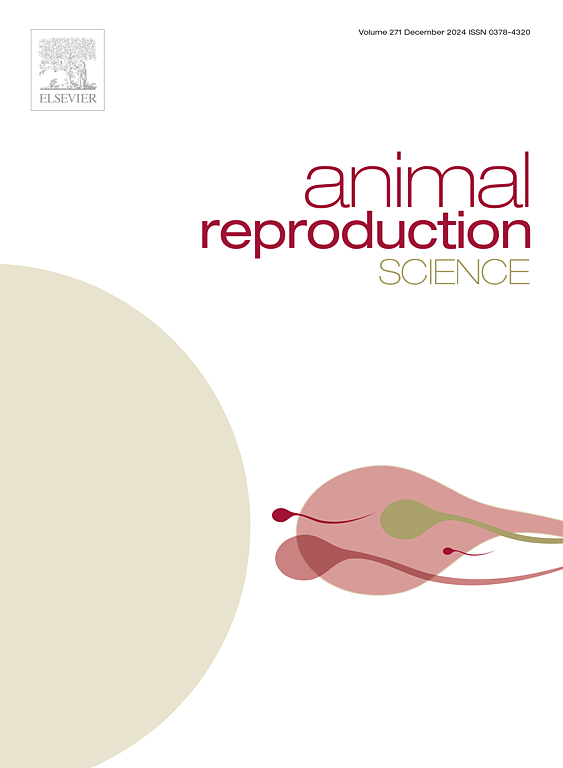NPC2, a seminal plasma protein with membrane cholesterol-binding ability, influences the cryotolerance and functionality of spermatozoa from Chino Santandereano bulls
IF 2.2
2区 农林科学
Q1 AGRICULTURE, DAIRY & ANIMAL SCIENCE
引用次数: 0
Abstract
Despite Latin America's rich biodiversity, active genetic material conservation programs are scarce. This study investigates potential freezability markers in both sperm and seminal plasma (SP) in Chino Santandereano, a Colombian Creole breed. Thirty ejaculates from ten Chino Santandereano bulls were cryopreserved and subsequently classified as of good (GFE) or poor (PFE) freezability according to their post-thaw total sperm motility (TMOT) and plasma membrane integrity (PMI). Sperm cholesterol and NPC2 protein levels in SP were measured prior to cryopreservation using colorimetric detection, densitometric quantification, and Western blot. Sperm functional competence (SFC), a functional test, was evaluated before and after cryopreservation. Correlation and t-student tests, a binomial regression model and two multiple linear regression models were utilized to evaluate the predictive power of NPC2 protein and sperm related variables. Two bands (14 kDa and 15 kDa) for NPC2 protein were identificated. NPC2 14 kDa is associated with a significant decrease in freezability (P < 0.01). The TMOT in fresh semen highly significant (P < 0.01) for sperm freezability and the interaction between NPC2 14 kDa and cholesterol content in sperm was significant (P < 0.01). Correlation between SFC and TMOT and PMI post-thaw (P < 0.01), along with the significantly different values between PFE and GFE (P < 0.05) were observed. We can conclude that NPC2 protein as a marker for sperm freezability of Chino Santandereano bull, and this depends on sperm content of cholesterol. In addition, our findings support the utility SFC combined tests in providing a precise assessment of sperm freezability.
NPC2是一种具有膜胆固醇结合能力的精浆蛋白,影响中国公牛精子的低温耐受性和功能。
尽管拉丁美洲拥有丰富的生物多样性,但积极的遗传物质保护计划却很少。本研究研究了哥伦比亚克里奥尔品种Chino Santandereano精子和精浆(SP)中潜在的冷冻性标志物。从10头中国桑坦德雷诺公牛中提取30份精液进行冷冻保存,并根据其解冻后精子总活力(TMOT)和质膜完整性(PMI)将其冷冻性分为良好(GFE)和差(PFE)。在冷冻保存前,使用比色检测、密度定量和Western blot检测SP中精子胆固醇和NPC2蛋白水平。精子功能能力(SFC)是一项功能测试,在冷冻保存前后进行评估。采用相关检验、t-student检验、二项回归模型和两个多元线性回归模型评价NPC2蛋白与精子相关变量的预测能力。鉴定出NPC2蛋白的两条条带(14 kDa和15 kDa)。NPC2 14 kDa与冻结性显著降低相关(P
本文章由计算机程序翻译,如有差异,请以英文原文为准。
求助全文
约1分钟内获得全文
求助全文
来源期刊

Animal Reproduction Science
农林科学-奶制品与动物科学
CiteScore
4.50
自引率
9.10%
发文量
136
审稿时长
54 days
期刊介绍:
Animal Reproduction Science publishes results from studies relating to reproduction and fertility in animals. This includes both fundamental research and applied studies, including management practices that increase our understanding of the biology and manipulation of reproduction. Manuscripts should go into depth in the mechanisms involved in the research reported, rather than a give a mere description of findings. The focus is on animals that are useful to humans including food- and fibre-producing; companion/recreational; captive; and endangered species including zoo animals, but excluding laboratory animals unless the results of the study provide new information that impacts the basic understanding of the biology or manipulation of reproduction.
The journal''s scope includes the study of reproductive physiology and endocrinology, reproductive cycles, natural and artificial control of reproduction, preservation and use of gametes and embryos, pregnancy and parturition, infertility and sterility, diagnostic and therapeutic techniques.
The Editorial Board of Animal Reproduction Science has decided not to publish papers in which there is an exclusive examination of the in vitro development of oocytes and embryos; however, there will be consideration of papers that include in vitro studies where the source of the oocytes and/or development of the embryos beyond the blastocyst stage is part of the experimental design.
 求助内容:
求助内容: 应助结果提醒方式:
应助结果提醒方式:


